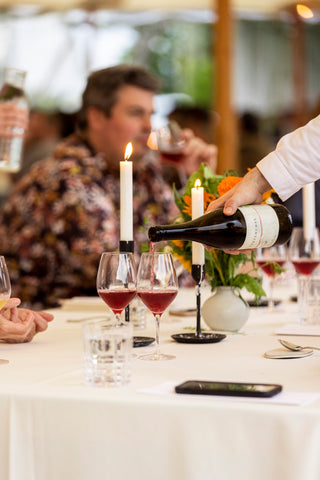Our wine pairing process, for this kind of event, always starts with the tasting of the wines. It is therefore with real excitement that Camilo, Francis and I embarked on the Menu Extra Mobile in the direction of Farnham. Arrived at the cellar (the place where the grapes are processed), a dozen wines were analyzed, discussed and (very little) spat.

It is a critical moment. We need to gather as much information as possible to direct the creation of the menu. Here is our procedure:
We begin by noting the cuvée, vintage, color, blend and ageing; in short, the synopsis of wine. Then we smell the aromas of the wine to determine if we can denote smells of fruits, flowers, spices, herbs, etc. The aromatic power is also taken into account; a very delicate wine that can be eclipsed by a very fragrant dish.
It is at this stage that we begin to imagine dishes, combining aromas with gastronomic ideas.
Finally, we taste the wines. For me, one of the most important characteristics to create a good pairing is the texture of the wine, an aspect modulated by acidity, alcohol, tannins or bitters, length and sugar. For example, just because a wine smells like strawberries doesn't mean it will go well with a strawberry cake, if the tannins and texture go against the composition of the cake, the mouthfeel will be mushy or destroy the smoothness of the dessert.

It is necessary to seize the first ideas of all. Camilo and Francis, both cooks, are already thinking instinctively about dishes or flavors that go well with the wines tasted!
Back at 5206 Saint-Laurent, the team began writing the menu. In addition to ensuring that the dishes are delicious and that the pairings are harmonious, you also have to think about the logistics, i.e. the possibility of serving this menu to 50 people, at the same time, in the middle of 'a field. These are quite intense moments where dishes will be scratched, redesigned, modified, and broken down, until the perfect result is achieved!
Pairings at the vineyard - Example
The PGG cuvée is extremely interesting to create an agreement; it is a wine with a fairly light weight, but a powerful volume. The aromas of the gewurztraminer are floral, reminiscent of exotic fruits and rose, while the pinot gris brings this beautiful depth to the wine (alcohol + roundness). We decided to accompany it with Bavarian peas. First, I wanted to accentuate the sensation of sweetness and sweetness that is unique to our Quebec peas . Then, the texture of the Bavarian is very creamy, so accompanying it with a less lively wine helps to preserve this unctuous sensation.

- Domaine Les Pervenches, Le Couchant, 2021 and artichoke.
The Couchant cuvée is one of the most beautiful Canadian wines, proving with each sip the beauty of a wine worked with mastery. For this pairing, we wanted to present a noble and fine product, preferring simplicity to let the wine express itself. Roasted artichoke and Jerusalem artichoke have this higher weight and these caramelized/vegetable aromas which are the perfect vectors to accentuate the power of the Couchant cuvée. In the mouth, the persistence of the two products created this impression of a perfect marriage, persistent over time.

How to influence the agreements during the service?
The first variable is the open time.
Some wines may exhibit what we call reduction, a sort of closure that can be easily resolved with contact with oxygen. Thus, certain wines, such as the Les Rosiers cuvée, were opened approximately 6 hours before serving, to allow them to reach their full potential during the tasting.

The second variable is temperature.
To reduce or increase certain sensations: acidity, aromatic power, tannins, we can modify the temperature of the wine. We have therefore chosen to serve the Pinot-Zweigelt cuvée at around 12 degrees Celsius, thus increasing the perception of freshness to better accompany the service of tomatoes and fresh pasta.
Other variables we used are the music chosen at the time of the tasting, the glassware and the order of the wines.
But the best way to make sure the deal is appreciated and understood is to talk about it. We all have a sensitivity to what we smell and what we eat, we are all capable of tasting! It is therefore by highlighting certain aspects of the wine and the pairing that we can really affect the perception of the guests, encouraging them to detect a specific aroma or characteristic.

How to make chords at home?
Like a musician, there is beauty in performing a simple chord that works. Of course, by following the theory and previous works, the novice will find adequate harmonizations.
There are many tools to orient yourself in the wine world; the immensity of online information, the SAQ representative, restaurant sommeliers, wine importers, etc. However, to really understand and create interesting pairings, the best and only way to go is to sample everything from the classics of Burgundy and Piedmont to wines from Moravia and the Finger Lakes!
So here is my advice for making chords at home; take the time to analyze what you are tasting and try to take into account the texture and weight of the wine when asking yourself these questions.
- Do I like it?
- How does my mouth feel? Is it refreshing, creamy, powerful, full-bodied, etc?
- Do I imagine myself eating, with this wine, a sour, spicy, warm, meaty, crunchy dish, etc.?
But there's also the surest way to hit deals every time; bother me.
One of the beauties of our world is the diversity of our cuisines, which testifies to deep-rooted traditions, unique terroirs and know-how that is both routine and legendary. Accompanying a meal with wine (or another drink) may seem complex and superfluous, but I believe it is an act that demonstrates a true love of hospitality.
 Thank you Vero & Mike for your trust!
Thank you Vero & Mike for your trust!
.
.





